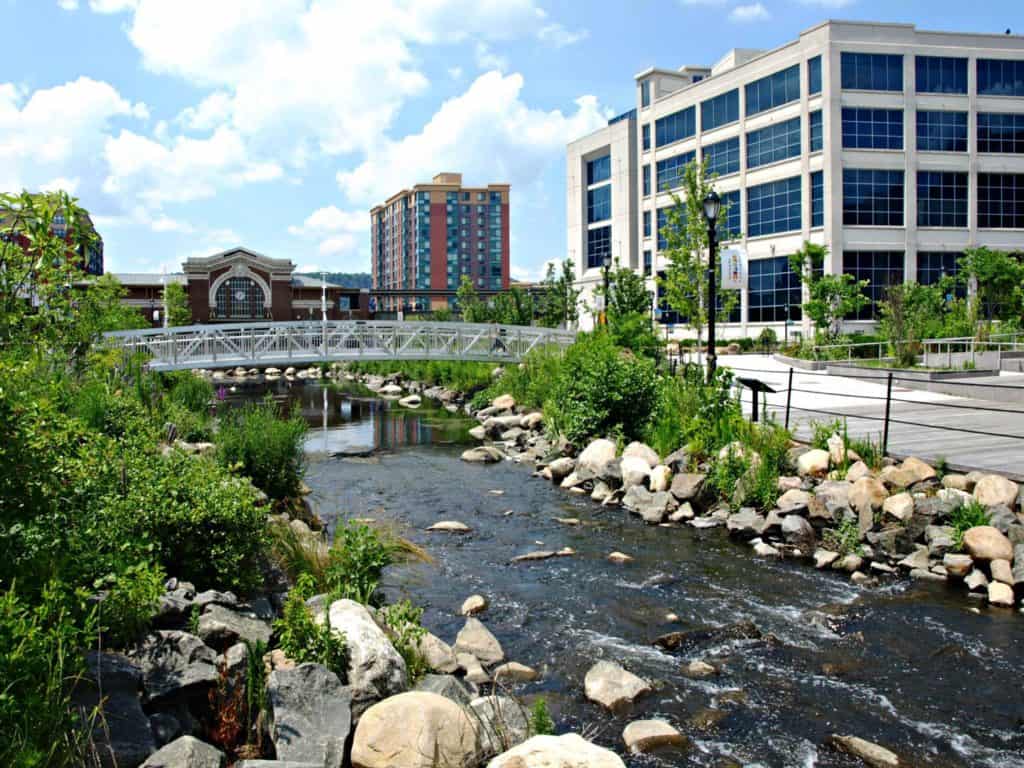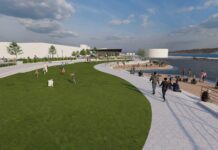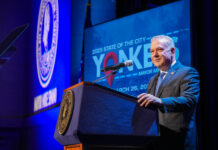
We are thrilled to share the news that National Geographic has featured the Yonkers Saw Mill River Daylighting Park in its September issue America the Beautiful. This park, known as Van der Donck Park, has become a landmark in Downtown Yonkers and continues to flourish.
The article, “America in a New Light” by Emma Marris, highlights conservation approaches outside of protected areas and introduces the idea that species can be conserved on working lands and in cities. This recognition serves as a proof point that environmental conservation and stewardship is possible in even the most unlikely of places.
As stated in the article, “This project, initiated by community leaders more than 20 years ago, is a hard-won and expensive reality, involving the state, the City of Yonkers, Groundwork, Scenic Hudson, and the U.S. Fish and Wildlife Service.” Yonkers mayor Mike Spano says the project has been “a major catalyst for the renaissance of downtown Yonkers and the city as a whole.” Other key partners include US Army Corps of Engineers, PS&S, Friends of Philipse Manor Hall, Westchester County, Scenic Hudson, the Yonkers Downtown BID, Beczak, and many other local residents and community leaders. We are so grateful to our friends at the Van Cortlandt Park Alliance who encouraged Ms. Marris to visit us, and are planning to daylight their urban creek, Tibbetts Brook, in the near future.
More from the National Geographic story, “Nothing illustrates the promise of urban con- servation more poetically than “daylighting” a creek. It’s easy to forget that all cities were built on ecosystems, and many had rivers and creeks running through them. As cities grew, these waterways were typically confined to pipes or culverts.
In Yonkers, an unofficial “sixth borough” just north of New York City, Saw Mill River, which once powered mills to cut timber and grind grain into flour, gradually turned into a polluted mess. In the 1920s the last 2,000 feet was covered with a parking lot. But since 2012, 800 feet of that section has run through a landscaped channel, sparkling in the sun in a new 2.2-acre park. More recently, other sections, deeper downtown, have been uncovered.
I take a train from Manhattan to Yonkers to see it. The creek turns out to be visible from
the platform. Just outside the station, I am met by Brigitte Griswold and Candida Rodriguez of
Groundwork Hudson Valley, one of the many organizations that helped unbury the creek.
We cross the street and take in the satisfying sight—and sound—of a burbling river in the cen-
ter of downtown. We see a fish ladder, installed for the sea-born eel babies—called “glass eels”
because they are completely transparent—to climb upstream to grow big.
This project, initiated by community lead- ers more than 20 years ago, is a hard-won and expensive reality, involving the state, the city of Yonkers, Groundwork, Scenic Hudson, and the U.S. Fish and Wildlife Service. That first 800 feet cost $24 million. But Yonkers mayor Mike Spano says the project has been “a major catalyst for the renaissance of downtown Yonkers and the city as a whole,” adding that it inspired more than four billion dollars in redevelopment, including 3,000 apartments.
“Green gentrification” can be an ironic consequence of urban conservation, but Yonkers has required some units to be low-income housing. After native plants were installed along the new channel, wildlife appeared as if by magic. Muskrat, herons, turtles, and ducks are spotted here regularly. Another section hosts a hydro-electric wheel that powers nearby streetlights.
In a streamside park, two men are whiling away the afternoon. “I like the water. I like the ducks,”
one tells us, appreciatively. Griswold once worked on more traditional conservation projects, but she wanted to do something that connected people to the non- human world—in part so they would come to care for it enough to fight for it. That meant doing it in the city. Not everyone can afford to
visit flagship national parks, she says.
Rodriguez shows me areas on a Yonkers map that were redlined—set aside for nonwhite residents, spurned by lenders. They have fewer trees and more concrete. Access to nature is not
evenly distributed. Fixing that injustice may be the best way to create a generation that cares enough about other species to save them.
Rodriguez says the daylighted creek offers a place for people to unwind, creates a buzzy
location for businesses, and protects threatened species like eels. “A triple win,” she calls it.
Griswold sums it up: “There’s a beautiful thing in downtown Yonkers, and it belongs to all of us.”





